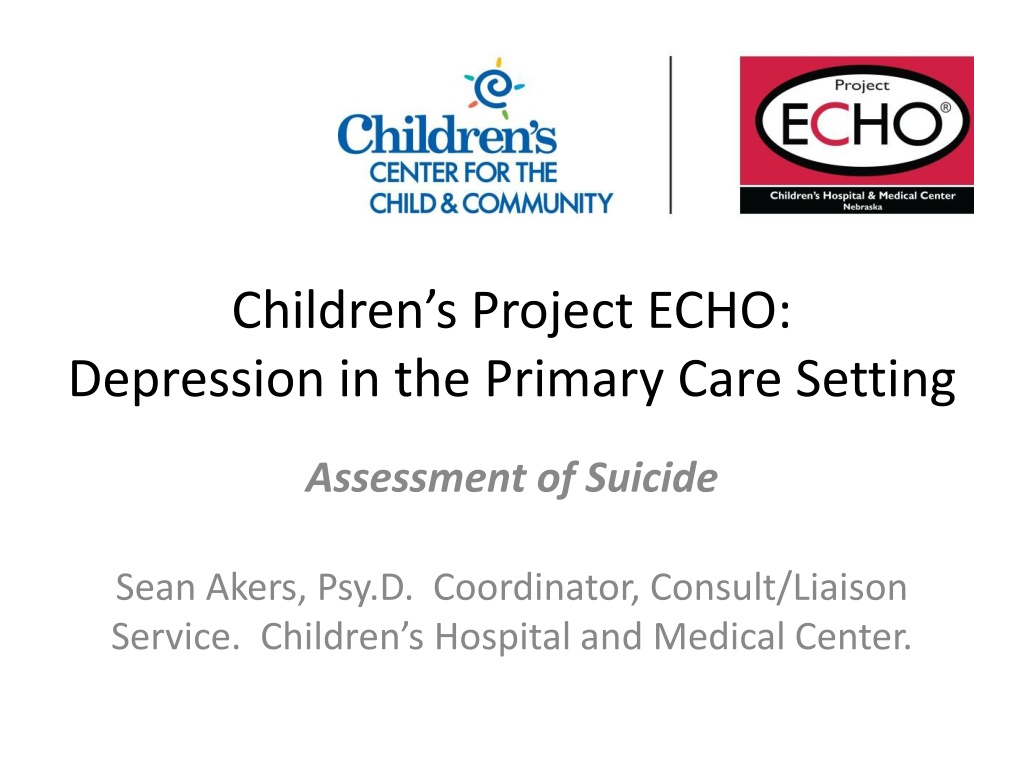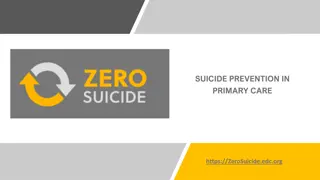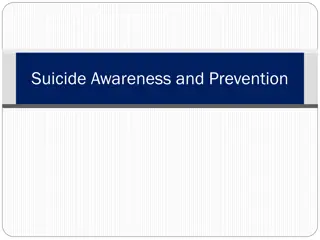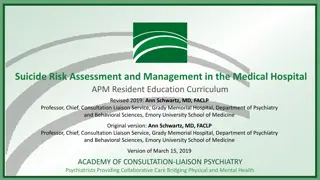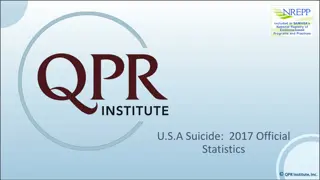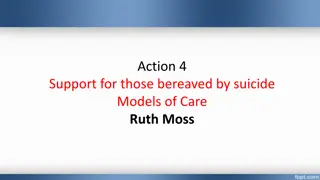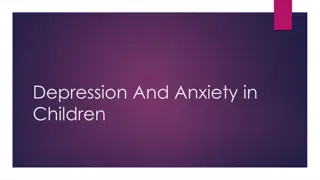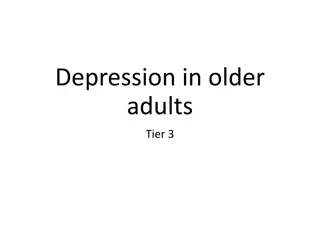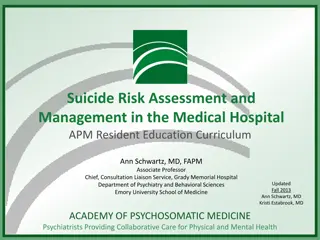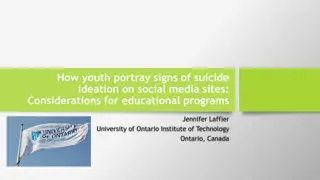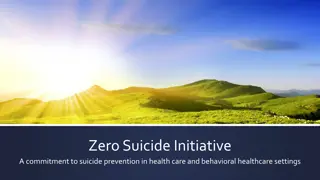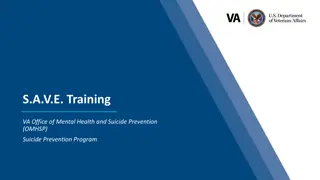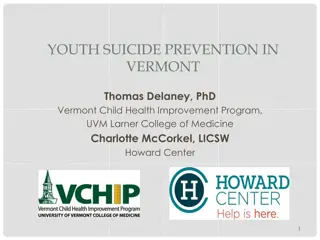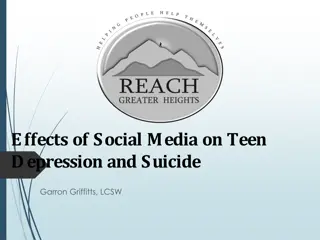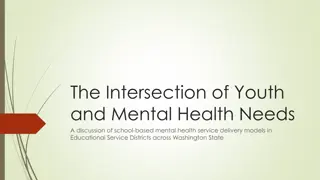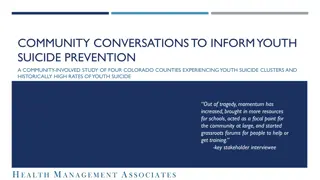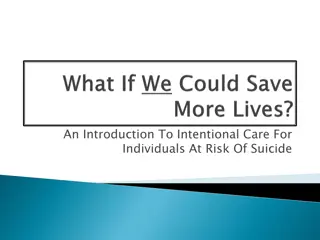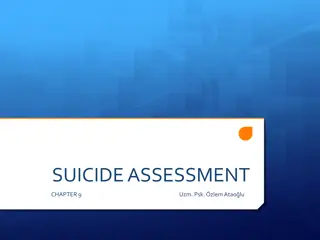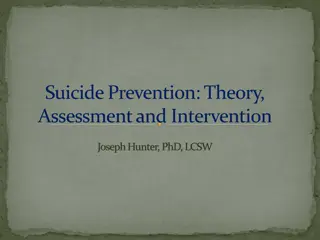Understanding Depression and Suicide Risk Assessment in Primary Care
This presentation explores the strong correlation between depression and suicide, emphasizing the importance of assessing suicide risk in primary care settings. It covers strategies for interacting with individuals struggling with depression and suicidal ideation, as well as discussing risk factors and recommendations for assessment post-suicide attempt. The content highlights the need to distinguish between depression as a risk factor for suicide and not every depressed individual being suicidal. Various assessment methods and treatment options are also addressed to help healthcare professionals effectively manage patients with suicidal tendencies.
Uploaded on Oct 03, 2024 | 0 Views
Download Presentation

Please find below an Image/Link to download the presentation.
The content on the website is provided AS IS for your information and personal use only. It may not be sold, licensed, or shared on other websites without obtaining consent from the author. Download presentation by click this link. If you encounter any issues during the download, it is possible that the publisher has removed the file from their server.
E N D
Presentation Transcript
Childrens Project ECHO: Depression in the Primary Care Setting Assessment of Suicide Sean Akers, Psy.D. Coordinator, Consult/Liaison Service. Children s Hospital and Medical Center.
Presenter Disclosures Consultant/ Speakers bureaus No Disclosures Research funding No Disclosures Stock ownership/Corporate boards-employment No Disclosures Off-label uses No Disclosures
Overview & Learning Objectives Examine the connection between depression and suicide. Understand the assessment process and treatment options following a suicide attempt. Explore strategies for interacting with someone struggling with depression and suicidal ideation.
Depression and Suicide Strong correlation between Depression and Suicide. Most common that person who attempts suicide has a history of Depression. Not every person who is Depressed is Suicidal Depression is a risk factor for suicide. Not every person who attempts Suicide is Depressed
Assessment of Suicide following attempt Prior to interview: 2 Questions: 1. What is the Goal for Assessment? Assess imminent risk Psychiatric hospitalization placement Vs Home with safety plan
Assessment of Suicide Prior to interview (chart review) 2. What are the facts of the case? Age, demographics Severity of suicide attempt Previous attempts, hospitalizations, self harm History of Depression Help seeking behavior Engaged in treatment Why? Helps guide the interview
Risk Factors and Recommendations Previous suicide attempts History of self harm History of Depression/suicidal ideation Alcohol/Drug Abuse Impulsive/Aggressive traits Hopelessness Intent Planned vs Impulsive attempt Access to lethal methods Family history of suicide attempts Mental health history, acceptance, current team
Interview 4 steps 1st Rapport building, introduce self, role, get them talking 2nd Assess presentation Guarded vs open, disengaged vs engaged, avoidance/minimizing, inconsistencies 3rd obtain basic history and events leading up to suicide attempt, assess all risk factors 4thgoal parent discussion Consistency of statements, safety, parent reaction
Inpatient Need Remain actively suicidal Ambivalence about surviving, wish successful Planned attempt, intent of dying Research methods, high lethality Unwilling to safety plan
Consider sending home Have an established treatment team, engaged Impulsive attempt (vs planned) First attempt (vs multiple) Told someone right after attempt Low lethality Motivation to improve (vs avoidance, denial) Family engagement and safety plan Substance abuse (vs suicidal ideation)
A Few Points For minors, generally need parent acceptance of hospitalization Unless clear immediate risk Goal is always to have a united team approach
Suicide Ideation Warning Signs (no attempt) Talk of wanting to die, no reason to live Hopelessness Telling others goodbye Increased risky behaviors (e.g. alcohol and drugs) Critical items on PHQ-9
Screening PHQ-9 Helps begin the conversation
Suicide Ideation no attempt Question remains, immediate risk/danger? Safety plan vs hospitalization More difficult to hospitalize unless immediate risk State verbally or PHQ-9 that they are currently experiencing suicidal ideation Can parent keep safe at home?
What can you do? Open discussion Be genuine Be caring Be direct and ask about suicide Destigmatize depression Destigmatize treatment Encourage help seeking behaviors, problem solving Not immediate fix, it s about engagement
Safety planning Restricting access to medications No weapons available Highly monitored, eyesight Pt agree to verbalize if ideation returns/intensifies
Case #1 16 year old boy Ingested 40 Tylenol Intention of dying History of Depression and suicidal ideation No therapist or psychiatrist Planned attempt, 3-4 days prior Did not tell anyone after until vomiting History of avoidance, isolating self Guarded and inconsistent during interview
Case #2 12 year old female Ingested 6 Ibuprofen Impulsive attempt following online bullying Told her mother immediately afterwards Recently started therapy for coping issues No history of behavioral issues, good student Cooperative and open to interview as were parents
